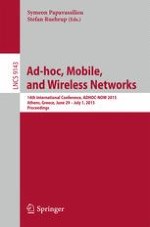This book constitutes the proceedings of the 14th International Conference on Ad Hoc Networks and Wireless, ADHOC-NOW 2015, held in Athens, Greece in June/July 2015. The 25 full papers presented in this volume were carefully reviewed and selected from 52 submissions. The book also contains 3 full-paper invited talks. The contributions are organized in topical sections named: routing, connectivity, and resource allocation; localization, sensor deployment, and mobility management; distributed computing with mobile agents; efficient, reliable, and secure smart energy networks; and emerging communications, networking and computing technologies for VANETs 2.0.
